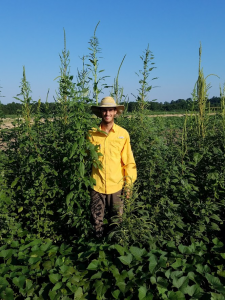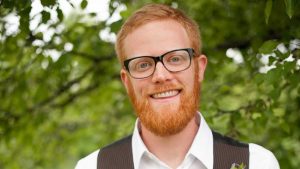Taking Aim at Destructive Weeds

Commonly referred to as pigweed, Palmer amaranth is one of the biggest production challenges farmers in the Southeast face. At NC State, scientists and graduate students are making progress toward lessening the weed’s impact in a range of crops.
Two of those students, Cole Smith and Nicholas Basinger, were recognized recently at the Weed Science Society of North Carolina for research they’ve conducted on Palmer amaranth and other destructive weeds. Smith won the society’s M.S. outstanding graduate student award, while Basinger won the Ph.D. student award.
Both studied with Katie Jennings, an associate professor in horticultural science and Extension specialist in weed management for small fruits and vegetables. Their projects were quite different:
Smith, of Hendersonville, explored chemical and cultural control of Palmer amaranth in sweet potatoes. Knowing that using cover crops with row crops can reduce the weed’s impact, he tested that practice in sweet potatoes.
Meanwhile, Basinger, of Greer, South Carolina, conducted a two-part study related to competition among weed species and crops. First, he looked at competition among Palmer amaranth and large crabgrass in sweet potatoes and soybean. He used those findings to inform the second part of his research, exploring whether remote light-sensing technology could help farmers differentiate the weeds and crops growing in their fields.
Recently, the two sat down to talk about their research, their career goals and what’s next for them after they graduate in May.
What led you to study weed science?
Smith: I went to undergrad here at NC State and majored in plant and soil science. I credit getting into weed science to two things: I worked with an organic grains research lab for two summers, and I had to pull a lot of weeds. I got tired of that and wanted other options. I also took Dr. Alan York’s weed science class, and I really enjoyed it. There are big issues related to weeds that require big solutions.
Basinger: For me, it was by happenstance that I got into weed science. I got an undergraduate degree in health and exercise science and had been accepted to physical therapy school, but after an internship, I decided that wasn’t the direction I wanted to go.
I ended up working on a small organic farm – actually two small farms in the western part of North Carolina. … Based on both of those experiences, I wanted to learn more about perennial fruit crops, and Katie Jennings and David Monks had an opening in their program and were willing to take me on to study vegetative strip width in wine grapes. So I came in thinking I was interested in the perennial fruit crop aspect of it, but I ended up really enjoying the weed science aspects of that work.
Why is your research important?
Smith: Palmer amaranth is pretty much in all row crops – corn, soybeans and cotton – and we’ve done studies where it reduced sweet potato production (at the Horticultural Crops Research Station in Clinton) by up to 96 percent.
Basinger: It grows quickly – about two inches a day. It’s like the kudzu of field crop weeds. Growers have very few options for controlling it because there are very few post-emergent herbicides registered for use [in sweet potato]. At the same time, it’s developing resistance to a lot of those chemistries, so once those weeds are up, really the only thing you can do in the field is pull them. Because it’s labor intensive, pulling weeds is expensive.
Smith: Palmer amaranth is a prolific seed producer, too: It’s been shown that a single plant can produce 600,000 seeds – but there have been reports of 1 million per plant. It’s a perfect storm.

Because of this research, it could be that we are able to determine the exact time we need to implement some sort of hand weeding or herbicide application. Or we know that over in this part of the field Palmer amaranth is a problem, but on this other part of the field, it’s large crabgrass. The way we manage those two weeds is completely different from one another, so instead of doing the whole field with hand labor, why don’t we say, ‘Alright, over here on this side, we are going to put our hand labor into play, but on this other side, we are going to do some post-emergent herbicide application.’ To be able to be surgical in implementing these management practices is going to allow farmers to be more efficient, to save money and to produce more food – and that’s what we want in the long run.
What’s next for you?
Smith: I’m working on that right now, looking mainly at research and extension jobs. I’m casting a wide net, both with industry and universities.
Basinger: I have just accepted a job at the University of Georgia as assistant professor of weed science. … It’s a research and teaching position in weed ecology and biology. I think that position is going to allow me to do some really cool research and take a closer look at how weed communities interact and how invasive species fill specific niches.
Is there anything else you’d like to share about your NC State experience?
Smith: I’d like to give kudos to Katie. I really enjoyed it. As you can tell, I’m quiet. She’s been good about really pushing me out of my comfort zone. That’s what I have really appreciated.
Basinger: I think Katie and David prepared us well to be out in the working world. Katie is not only interested in us getting our research done, she also recognizes that we are people, too. They both pushed us to be more well-rounded.
You can make a difference in the lives of students like these!
This post was originally published in College of Agriculture and Life Sciences News.


